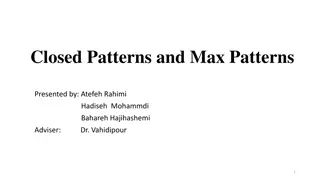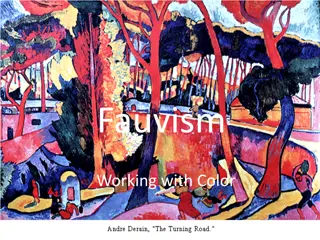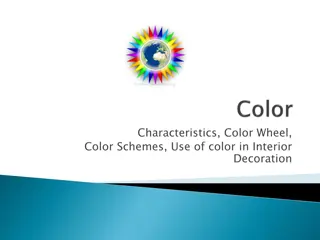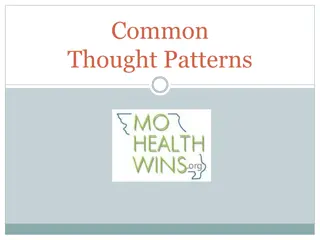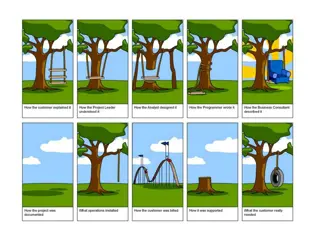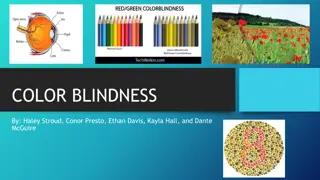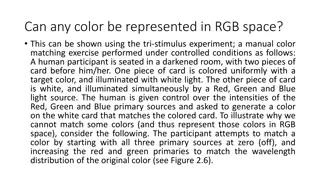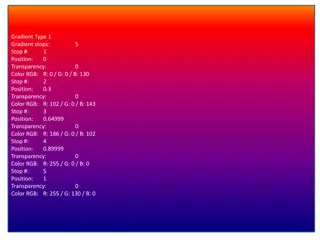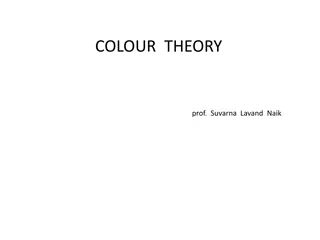Planning with CSC Continuum of Welsh Language Patterns
This session by Mathias Maurer provides information and examples to support planning with the CSC Continuum of Welsh Language Patterns. It covers introducing new language patterns, transferring familiar patterns to new contexts, planning for progression, and utilizing the continuum for coherent deve
1 views • 44 slides
Color Accessibility Guidelines and Examples
Enhance color accessibility in presentations by following Louisiana Tech University's guidelines for using brand colors, text sizes, and color combinations. Learn how to create visually inclusive content and promote readability for all audiences. Explore approved color palettes and typography recomm
2 views • 11 slides
Fun Art Task: Creating a Color Wheel
Explore color relationships by mixing secondary and tertiary colors to create a vibrant color wheel. Learn about primary, secondary, and tertiary colors, and follow step-by-step instructions to create your own color wheel using basic art supplies. Enhance your understanding of color theory through t
1 views • 12 slides
Patterns of Behaviour in Zoology: An Overview
Behaviour in animals encompasses a wide range of responses to stimuli in their environment, with patterns that can be innate or learned. This comprehensive overview explores the different behavioural patterns, including tropism, taxis, reflexes, instincts, learning, and reasoning. The importance of
0 views • 17 slides
Frequent Patterns and Association Rules in Data Mining
Frequent pattern mining involves identifying patterns that occur frequently in a dataset, such as itemsets and sequential patterns. These patterns play a crucial role in extracting associations, correlations, and insights from data, aiding decision-making processes like market basket analysis. Minin
3 views • 95 slides
Year 2 Mathematics Geometry Patterns and Sequences
Exploring 2D and 3D shape patterns, ordering and arranging mathematical objects in sequences. Tasks involve continuing rotation patterns, mental math exercises, and creating unique shape patterns. Emphasis on rules for patterns and developing critical thinking skills in geometry.
2 views • 18 slides
Limit Test of Iron Based on Color Reaction with Thioglycollic Acid
The limit test for iron involves the reaction of iron in ammoniacal solution with citric acid and thioglycollic acid to form a reddish-purple color. By comparing the color produced with a standard solution, the presence of iron is determined. Citric acid prevents precipitation of iron, while thiogly
1 views • 5 slides
Mastering Color in Film: A Comprehensive Guide to Using Color Grading Techniques
Explore the intricate world of color in filmmaking through understanding color grading, log explained, Log rec.709, color correction, and grading techniques without LUTs. Enhance your storytelling by harnessing the power of color to evoke emotions and create visual impact in your films.
4 views • 6 slides
Closed Patterns and Max Patterns in Data Mining
Explore the concepts of closed patterns and max patterns in data mining, along with challenges and solutions. Learn how closed patterns compress frequent patterns while maintaining support information, and how max patterns provide a lossy compression. Discover the difference between closed patterns
0 views • 10 slides
Fun with Patterns: Exploring Creativity and Logic in Mathematics
Dive into the world of patterns with this interactive mathematics chapter, learning how to identify, extend, and create patterns using everyday objects like flowers and leaves. Explore the art of pattern-making, discover the magic of number patterns, and engage in hands-on activities to enhance your
1 views • 39 slides
Fauvism: Working with Colors and Color Schemes
Fauvism is an art movement known for its bold and arbitrary use of colors. Fauvist painters carefully selected colors to convey specific moods in their artworks. This guide explores Fauvism, color theory, and different color schemes to help you create your own expressive painting. Learn about comple
0 views • 8 slides
Evaluation of Ocean Color Inversion Models for Retrieving Marine IOPs
Evaluating and generalizing ocean color inversion models to retrieve marine inherent optical properties (IOPs) is essential for understanding ocean dynamics. This involves choosing the right algorithm and validating its effectiveness, as discussed in the Ocean Optics Summer Course at the University
0 views • 23 slides
Color Theory: A Comprehensive Guide
Practical guidance on color theory including the color wheel, color schemes, and color psychology. Learn about the importance of utilizing various color schemes like monochromatic, complementary, and analogous to create effective designs. Understand how different colors convey meanings and emotions
0 views • 11 slides
Analysis of Gathering Patterns from Trajectories - ICDE 2013
Prevalence of trajectory data due to location acquisition technology enables understanding movement behaviors, group travel patterns, and anomaly detection. Co-travellers patterns like Flocks, Convoys, and Swarms are defined based on group characteristics. Gathering patterns involve events with cong
2 views • 20 slides
Color: Characteristics, Color Wheel, and Interior Decoration
Color is a vital aspect of our everyday lives, evoking various emotions and perceptions. This article delves into the characteristics of color, the color wheel, color schemes, and the use of color in interior decoration. It explains how colors are perceived, the qualities of color like hue, value, a
1 views • 51 slides
Fun and Educational Color Mixing Experiment for Elementary Students
Engage elementary school students in a hands-on color mixing experiment using primary colors to create secondary colors. The activity involves visual demonstrations, color paddles, and mixing colored goo in bags to understand color blending and create unique color combinations. Through this interact
0 views • 7 slides
Design Patterns in Java Programming
Learn about design patterns in Java programming, including creational patterns such as Singleton, Factory, and Builder. Explore how design patterns provide solutions to common programming problems, making code more flexible and efficient. Dive into examples and implementations to enhance your unders
0 views • 31 slides
Design Patterns for Software Development
Explore the world of design patterns in software development, including structural decomposition, organization of work, access control, and communication patterns. Learn the differences between design and architectural patterns, and how they influence software systems. Discover categories of design
3 views • 107 slides
Color Decorating Tips: The 60-30-10 Rule for a Balanced Room Palette
Utilize the 60-30-10 rule when selecting colors for a room: 60% for walls, 30% for furniture, and 10% for accents. The dominant color should complement the room's style, with the secondary color harmonizing with it. The accent color adds a bold touch through decorations. Consider existing furniture
0 views • 7 slides
Common Thought Patterns in Communication
Common thought patterns in communication help structure messages effectively to increase understanding and engagement. Recognizing these patterns benefits readers by enhancing comprehension, engagement, recall, and writing skills. The five most common thought patterns are list, sequence, definition,
0 views • 16 slides
Introduction to Software Design Patterns in CSE 331 Spring 2015
Dive into the world of design patterns with a focus on creational patterns, structural patterns, and behavioral patterns in the context of software design and implementation. Explore concepts like encapsulation, subclassing, and iteration along with their problems, solutions, advantages, and disadva
0 views • 48 slides
Balance and Color in Design
Explore different types of balance in design, such as symmetrical, asymmetrical, and radial, and learn about color theory concepts like color schemes, color wheels, and contrast. Discover how colors interact, create focal points, and influence the overall composition in visual design.
0 views • 33 slides
Developing Number Sense in the Classroom
Explore various strategies to help young children develop number sense, including subitizing, finger patterns, spatial patterns, pair-wise patterns, five-wise patterns, partitions of five and ten, and adding and subtracting to 10. These activities involve using visual aids, dice patterns, finger cou
0 views • 46 slides
Attributes and Color Schemes in Graphics
Graphics systems utilize attributes to define how primitives are displayed, such as color and size, while color and grayscale can be stored in different ways like direct storage and indexed storage schemes. The RGB color components play a key role in determining the color shades, with various color
0 views • 51 slides
Design Patterns in Software Development
Learn about design patterns in software development, including creational patterns like Singleton, Factory, and Builder. Discover how design patterns provide solutions to common programming problems, increase code flexibility, and improve program design. Gain insights into the concepts of Singleton
0 views • 33 slides
Design Patterns: A Comprehensive Overview
Exploring the world of design patterns, this content delves into the essence of design patterns, their application in software design to resolve complexity, and the different types of design patterns - creational, structural, and behavioral. It also showcases examples of popular design patterns such
0 views • 22 slides
Introduction to Design Patterns: Understanding GOF Patterns
Explore the world of design patterns with a focus on Gang of Four (GOF) patterns. Understand the essence of design patterns, learn about GOF patterns, and discover how to select, apply, and use these patterns effectively. Dive into the fundamentals of design patterns, including creational and struct
0 views • 115 slides
Color: A Comprehensive Overview
Color is a fascinating aspect of our visual world, explored through the prism of science and light. This chapter delves into the origins of color perception, from Isaac Newton's study of the color spectrum to the reflection and transmission of light that determines how we see colors. Gain insights i
0 views • 28 slides
Color Blindness: Causes, Symptoms, and Types
Color blindness, also known as color vision deficiency, is a genetic disorder that affects the ability to distinguish between certain colors. It is caused by the absence of color-sensitive pigment in cone cells of the retina, often passed down on the X chromosome. Symptoms vary from difficulty diffe
2 views • 16 slides
The Impact of Colors on Decision Making in Visual Displays
Investigating the influence of color on decision-making, particularly in legal contexts, through the manipulation of photographs with different color schemes. Prior research suggests that color can play a crucial role in how visuals are perceived and remembered, especially in litigation settings. By
0 views • 37 slides
Basics of Color Theory
Understand the essence of color with insights into the sources, perception, and interpretation of color. Dive into the color wheel, primary, secondary, tertiary, warm, cool, and neutral colors, and learn about color harmony to create visually pleasing designs.
0 views • 14 slides
Color Representation: RGB vs. CIE vs. HSV Models
Exploring the limitations of representing all colors in RGB space and the alternative approaches offered by the CIE color space and HSV color model. While RGB is limited by additive primaries, CIE provides a broader range of color representation, and HSV simplifies color perception by emphasizing hu
0 views • 8 slides
Color Blindness: Types, History, and Impacts
Color blindness, also known as color vision deficiency, affects individuals by limiting their ability to perceive certain colors. It was first discovered by John Dalton, who suffered from red/green color blindness himself. The two main types are red/green and blue/yellow color blindness, each with i
0 views • 19 slides
Color Blindness: Causes, Symptoms, and Diagnosis
Color blindness, also known as color vision deficiency, is a genetic disorder that affects the ability to distinguish between colors. John Dalton discovered color blindness in 1794. It is inherited in an X-linked recessive pattern and can cause difficulties in daily life, such as trouble seeing colo
0 views • 13 slides
Gradient Types and Color Patterns
The content describes various gradient types and color patterns using RGB values and positioning to create visually appealing transitions. Each gradient type showcases a unique set of color stops and positions. The provided information includes detailed descriptions and links to visual representatio
0 views • 24 slides
Design Principles: Contrast, Repetition, Alignment, Proximity, Color Theory
Explore the significance of design principles such as contrast, repetition, alignment, proximity, and color theory in creating visually appealing and effective designs. Learn how contrast plays a vital role in guiding the viewer's attention and enhancing visual interest through various techniques li
0 views • 30 slides
Impact of Color in Film Studies
Delve into the fascinating world of color in films through a series of engaging activities and discussions. From black and white classics to vibrant modern movies, uncover how color choices influence storytelling, evoke emotions, and captivate audiences. Explore the history, science, and psychology
0 views • 6 slides
Overview of Color Models in Computer Graphics
Color models in computer graphics play a crucial role in creating a wide range of colors using a limited set of primary colors. There are two main types of color models - additive and subtractive, with RGB being common for displays and CMYK for printing. RGB is additive, combining red, green, and bl
0 views • 16 slides
Is Clarifying Shampoo Suitable for Color-Treated Hair
Color-treated hair requires special care, as it is often more vulnerable to dryness, damage, and color fading. For many people, clarifying shampoo has become an essential part of their haircare routine, but is it safe for those with color-treated hai
0 views • 4 slides
Color Theory: Basics and Applications
Color theory encompasses the color wheel, color harmony, and how colors are used. It provides a logical structure for organizing and creating colors. Primary, secondary, and tertiary colors play key roles in this theory, along with concepts like color harmony and context. By understanding color theo
0 views • 28 slides








